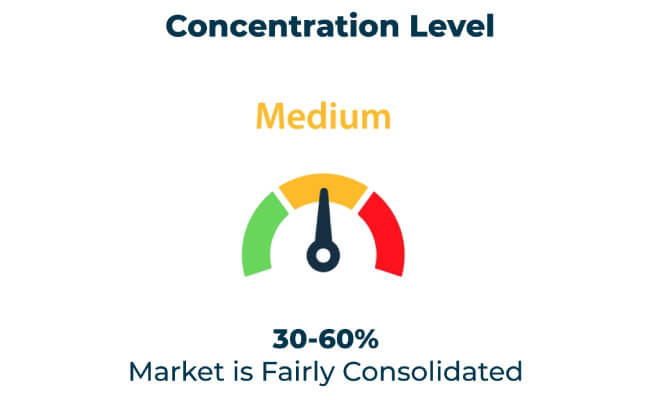The plastic jar packaging market is growing steadily due to the demand for versatile, durable, and lightweight packaging solutions. By 2035, the market is projected to reach USD 29765.91 million, growing at a compound annual growth rate (CAGR) of 4.4%. Key drivers include the rise of e-commerce, increased focus on convenience packaging, and advancements in recyclable plastic materials.
Manufacturers are innovating with eco-friendly materials and customized designs to meet diverse industry needs. Partnerships with food, personal care, and pharmaceutical sectors are enhancing product alignment with regulatory and consumer trends.
| Attribute | Details |
|---|---|
| Projected Value by 2035 | USD 29765.91 million |
| CAGR during the period 2025 to 2035 | 4.4% |
Exclusive Offer: 30% Off on Regional Reports
Get a free sample report and customize your regions for a 30% discount on your regional report!
Summary
The SWOT analysis highlights the positioning of leading companies in the plastic jar packaging market. Amcor leads with innovation and sustainable solutions but faces challenges in high raw material costs. Berry Global is recognized for its extensive product range and manufacturing capabilities, though competition in emerging markets is a hurdle.
Silgan Holdings specializes in customized and functional designs but contends with fluctuating market demand. Opportunities lie in developing advanced recycling methods and smart packaging solutions, while threats include stringent regulations and rising material costs.
Amcor
Amcor's leadership is fueled by its innovative approach to sustainable packaging, with a focus on recyclable and lightweight plastic jars. Its strengths include global operations and advanced technology, but high raw material costs and dependency on key markets pose challenges.
Opportunities exist in expanding its sustainability-focused product lines and collaborating with e-commerce giants. The company faces threats from increasing regulatory restrictions on plastic usage and competition from alternative materials.
Berry Global
Berry Global is known for its vast product range and strong manufacturing capabilities. It excels in providing customizable solutions for diverse industries such as food and healthcare. However, competition in price-sensitive emerging markets affects its market share.
The company can capitalize on opportunities by introducing advanced, eco-friendly products and leveraging automation to reduce production costs. Threats include fluctuating material prices and increasing demand for non-plastic alternatives.
Silgan Holdings
Silgan Holdings stands out for its expertise in functional and customized plastic jar designs. The company’s focus on innovation and strong relationships with end-use industries ensures its relevance. Challenges include fluctuating market demand and limited adoption of advanced recycling technologies.
Opportunities lie in scaling production for eco-friendly and smart packaging solutions, while threats come from evolving environmental regulations and competitive pressures.
| Category | Market Share (%) |
|---|---|
| Top 3 Players (Amcor, Berry Global, Silgan Holdings) | 17% |
| Rest of Top 5 Players (Gerresheimer, Graham Packaging) | 09% |
| Next 5 of Top 10 Players | 06% |
Type of Player & Industry Share (%)
| Type of Player | Market Share (%) |
|---|---|
| Top 10 Players | 32% |
| Next 20 Players | 38% |
| Remaining Players | 30% |

Year-on-Year Leaders
North America focuses on product safety and sustainability, driving demand for recyclable plastic jars. Europe leads with stringent regulations encouraging bio-based and recyclable materials. Asia-Pacific experiences rapid growth due to industrialization and rising disposable incomes, while emerging markets present opportunities for low-cost and eco-friendly packaging solutions.
Check Free Sample Report & Save 40%!
Select your niche segments and personalize your insights for smart savings. Cut costs now!
Emerging markets in Asia-Pacific, Africa, and South America offer substantial growth potential. Scalable and sustainable plastic jar solutions are increasingly in demand in these regions.
In-House vs. Contract Manufacturing
Regional dynamics drive the plastic jar packaging market. North America emphasizes sustainability and regulatory compliance, while Europe leads with innovations in bio-based and recyclable materials. Asia-Pacific is a growth hub, driven by industrialization and rising disposable incomes. Emerging markets in Africa and South America offer opportunities for affordable, scalable packaging solutions.
| Region | North America |
|---|---|
| Market Share (%) | 30% |
| Key Drivers | Focus on sustainability and regulatory support. |
| Region | Europe |
|---|---|
| Market Share (%) | 35% |
| Key Drivers | Innovation in bio-based and recyclable materials. |
| Region | Asia-Pacific |
|---|---|
| Market Share (%) | 25% |
| Key Drivers | Industrialization and rising disposable incomes. |
| Region | Other Regions |
|---|---|
| Market Share (%) | 10% |
| Key Drivers | Opportunities in emerging markets. |
The plastic jar packaging market is set to expand through innovations in sustainability, smart technologies, and material efficiency. Companies prioritizing eco-friendly production, smart features, and partnerships with key industries will lead the market. Expanding into emerging regions and catering to e-commerce needs will be key growth drivers.
| Tier | Key Companies |
|---|---|
| Tier 1 | Amcor, Berry Global, Silgan Holdings |
| Tier 2 | Gerresheimer, Graham Packaging |
| Tier 3 | Plastipak, Alpha Packaging, RPC Group |
The plastic jar packaging market is poised for steady growth, driven by sustainability initiatives, technological advancements, and e-commerce expansion. Companies focusing on eco-friendly materials, advanced designs, and smart features will dominate the competitive landscape.
Key Definitions
Abbreviations
Research Methodology
This report is based on primary research, secondary data analysis, and market modeling. Industry expert consultations validated insights.
Market Definition
The plastic jar packaging market includes jars made from recyclable and bio-based materials, designed for use across food, personal care, pharmaceutical, and e-commerce industries.
Rising demand for recyclable and lightweight packaging solutions.
The market is projected to reach USD 29765.91 million, growing at a compound annual growth rate (CAGR) of 4.4%.
Amcor, Berry Global, and Silgan Holdings are market leaders.
High raw material costs, regulatory pressures, and limited recycling infrastructure.
Opportunities include innovations in sustainability, smart features, and e-commerce expansion.
Explore Packaging Formats Insights
View Reports
Thank you!
You will receive an email from our Business Development Manager. Please be sure to check your SPAM/JUNK folder too.